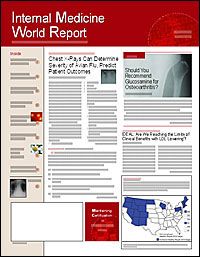Publication
Article
Internal Medicine World Report
New Clot Drugs May Help Patients after Hip, Knee Surgery
ATLANTA?Investigators presented positive new studies on advances in preventing or treating blood-clotting malfunction after major joint surgery. Some even suggested that a new era in clot prevention was in progress, and the current gold standard would follow the dinosaur, according to new data presented at the American Society of Hematology annual meeting.
"Since we're aware of the risk factors, thromboembolic disorders should be preventable or easily treated," said Katherine A. High, MD, an expert from the Howard Hughes Medical Institute, Philadelphia, who reviewed the studies but was not an investigator. "Current therapies, while effective, still have many limitations and serious side effects. Technologic advances and new treatment options with increased safety and efficacy are sorely needed."
Deep vein thrombosis, for example, is difficult to detect in many patients, although it is a clot that may partially or completely block a blood vessel, according to Dr High. "Such clots form in deep veins, usually in the calf, thigh, knee, or pelvis. Left untreated, patients can develop a pulmonary embolism, leading to severe respiratory dysfunction," she explained. "Major orthopedic surgery particularly increases a patient's risk of developing clots that break apart and travel to the lung."
One hopeful drug in clinical development is BAY 59-7939 (called BAY; Bayer), an oral, direct factor Xa inhibitor. "Factor Xa is the common point between extrinsic pathways which initiate the clotting pro?cess and intrinsic pathways which amplify it," explained Alexander G.G. Turpie, MD, Hamilton Health Sciences, General Hospital, Hamilton, Ontario, Canada. "It's exciting to know that BAY inhibits factor Xa by itself and does not require the presence of cofactors to exert its effects."
He presented a study with additional data from 2 previous multicenter, multinational trials, in which the safety and efficacy of BAY for thromboprophylaxis were compared with enoxaparin (Lovenox). The first trial, focusing on patients who underwent elective total hip replacement surgery, took place in Europe; the second, looking at total knee replacement surgery, was conducted in North America.
A total of 1343 patients were randomized to re?ceive either twice-daily doses of oral BAY ranging from 2.5 to 30 mg, or sub?cutaneous enoxaparin (40 mg once daily starting 12 hours before hip surgery or 30 mg twice daily starting 12 hours after knee surgery) for 5 to 9 days after surgery; at that time, an x-ray study of the veins was taken.
Dr Turpie concluded, "Analysis of these phase 2 data confirms that a total daily dose of 5 to 20 mg of oral BAY has ?similar efficacy and safety to ?subcutaneous ?eno?xa?parin for the prevention of ?throm?boem?bolic events after major orthopedic surgery."?
Another investigational oral direct ?inhi?bitor of activated factor Xa, LY517717 (Eli Lilly), seems to interrupt thrombus ?formation without impairing platelet hemostatic function. "It has the ?potential to rap-idly change the current therapeutic scenario," says lead investigator Giancarlo Agnelli, MD, of the Uni?versity of Perugia, Italy.
In a double-blind, dose-escalation study conducted to compare LY517717 and eno?xa?parin for preventing venous thromboembolism after total knee or hip surgery, 511 patients were randomized to receive 1 of 6 oral doses of the new agent (25, 50, 75, 100, 125, or 150 mg) or 40 mg enoxaparin once daily. The 3 highest doses of LY517717 and enoxaparin were found to have similar efficacy and safety.?N.P. ? ? ? ? ? ? ? ? ? ? ? ? ?





